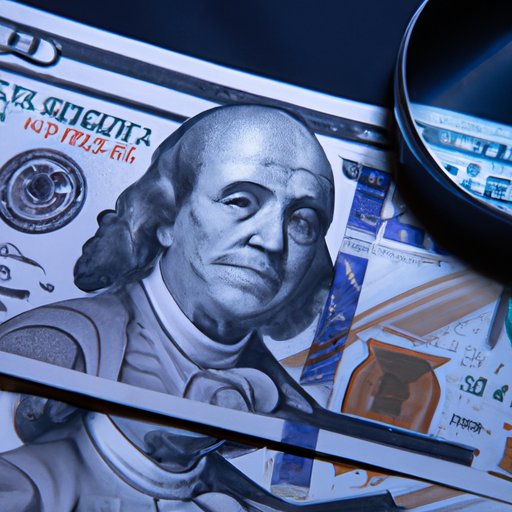
I. Introduction
Counterfeit money is a major issue that affects people all around the world. With increasingly sophisticated technologies available, it is becoming easier for criminals to produce high-quality fake notes that can be difficult to detect. However, there are several ways to identify fake cash, and it is crucial for individuals to be able to identify it. In this article, we will explore the importance of knowing how to identify fake cash, as well as the different techniques you can use to detect counterfeits.
II. 5 Simple Ways to Spot Counterfeit Money: A Guide for Everyday Use
Identifying fake cash doesn’t have to be complicated. Here are five simple techniques you can use to detect counterfeit notes:
A. Feeling the texture
Real currency is printed on high-quality paper or polymer, which has a unique texture that is difficult to replicate. If the paper or polymer feels wrong, the note could be counterfeit.
B. Checking the watermark
Most legitimate notes have a watermark that can only be seen when you hold the note up to the light. The watermark should be a clear and distinct image that is visible from both sides of the note. If there is no watermark or it looks unusual, the note may be counterfeit.
C. Using a counterfeit detector pen
Counterfeit detector pens use a specially formulated ink that reacts with starch found in most types of paper. If the ink turns a dark color, the note is likely counterfeit.
D. Examining the printing quality
Look for intricate details and fine lines that are present in real currency, but may be missing or poorly reproduced in counterfeit notes. Check to see if the print quality is consistent throughout the note, especially around the edges and corners.
E. Checking for serial numbers and seals
Most genuine notes have a unique serial number that is different for every note. Additionally, they may contain seals, such as a raised print or a hologram. Check to make sure that these details are present and match the standards established by the country’s currency authority.
III. The Ultimate Guide to Detecting Counterfeit Cash
For those who need to deal with large amounts of cash, it is important to be able to identify more advanced security features. Some of these features include:
A. Checking for security threads
Most genuine notes have a security thread that can be seen when the note is held up to the light. The thread will usually have the note’s value or a unique design printed on it. If the thread is missing or looks wrong, the note may be counterfeit.
B. Looking for color-shifting inks
Many currencies now use color-shifting inks that change color when viewed from different angles. These inks can be difficult to replicate, so their presence is a good indication that the note is genuine.
C. Examining microprinting
Microprinting is a technique used to print tiny text on currency that is not easily visible to the naked eye. Look for small letters or numbers that are crisp and clear. If the text is blurry or illegible, the note may be counterfeit.
D. Identifying watermarks
Watermarks on high-quality paper currency can have complex designs that are difficult to reproduce. Ensure the watermark is a part of the note and that it aligns with printed images on the note.
E. Testing holograms and other security features
Many currencies use holograms and other security features that can be difficult to reproduce. These include raised print, color-shifting ink, and fine-line printing. Ensure that they are present and have a high-quality look.
IV. Don’t Be Fooled: How to Identify Fake Currency
Real-life examples of counterfeit money being passed unnoticed are all too common. Education and awareness are crucial in preventing people from being scammed. Here’s some practical advice:
A. Real-life examples of counterfeit incidents
Examples of previous scams targeted at businesses and customers.
B. Practical advice on detecting fake bills in everyday situations
Advice on measures to take when dealing with cash transactions everyday, paying attention to the currency type and amount.
C. How to avoid getting scammed
Tips on protecting yourself from scams and handling counterfeit currency with care.
V. Protect Yourself: How to Avoid Accepting Fake Money
Business owners, cashiers, and individuals who handle cash regularly must be extra vigilant and ensure that they are not accepting counterfeit notes. Here are some tips:
A. Advice for business owners and cashiers
Training and procedures can help prevent the acceptance of counterfeit bills. Businesses can purchase counterfeit detection machines, use an official currency counting and sorting machine or train employees to look out for counterfeit features found in currency notes.
B. Tips for identifying fake bills before accepting payment
How to examine and detect counterfeit currency before accepting it.
C. What to do if you come across counterfeit money
Non-judgmental advice on what to do upon recognizing counterfeit notes after accepting payment.
VI. Counterfeit Money 101: What You Need to Know
Counterfeiting is a criminal offense that can carry serious legal consequences. Here are some things you should know:
A. Legal consequences of passing fake currency
The legal ramifications and consequences of possessing, passing, and manufacturing counterfeit notes.
B. What to do if you accidentally receive fake money
Proven steps to take if you recognize receiving counterfeit currency.
C. How the government fights counterfeit money
Efforts the government takes in fighting the proliferation of counterfeit bills, including laws, regulations, enforcement and education.
VII. Conclusion
The ability to recognize counterfeit money is essential for individuals, businesses and organizations. It is not only the legal obligation but also an ethical responsibility to avoid passing on counterfeit notes to others. Following the tips outlined above can help reduce your chances of falling prey to counterfeit scams. We encourage readers to spread awareness about the issue so we can all be more vigilant and aware of the signs of counterfeit currency. Together, we can all play a vital role in preventing counterfeit money from entering into the circulation of the economy.




